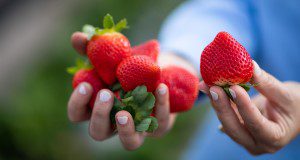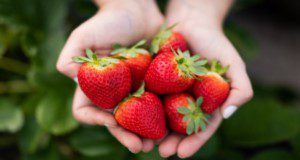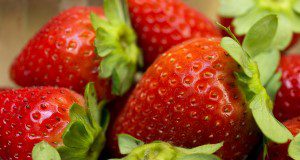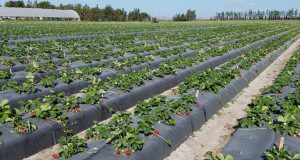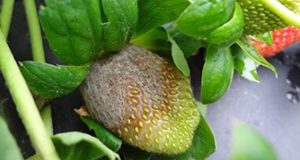Several different fungi and one bacterium cause leaf spot diseases of Florida strawberry. Symptoms caused by these pathogens are often similar, leading to confusion and misdiagnosis of the disease. To facilitate diagnosis, the most common leaf spots diseases of strawberry in Florida are described in this new 6-page article, written by Juliana S. Baggio, James C. Mertely, and Natalia A. Peres, and published by the UF/IFAS Plant Pathology Department.
https://edis.ifas.ufl.edu/pp359
Tag: Strawberry Diseases
Pestalotia Leaf Spot and Fruit Rot of Strawberry
Pestalotiopsis-like fungi cause diseases on many different species of plants worldwide, including strawberry. The pathogen is not necessarily new to strawberry and was first reported causing fruit rot in Florida and Israel in the 1970s. However, during the 2018–19 and 2019–20 strawberry seasons, severe and unprecedented outbreaks were reported in Florida, characterized by symptoms on nearly all plant parts including roots, crowns, petioles, fruit, and leaves. This new 4-page publication of the UF/IFAS Plant Pathology Department describes the disease and its causal agent and briefly covers what is known about disease development and control practices. This document will provide valuable information to strawberry nursery and fruit production growers. Written by Juliana S. Baggio and Natalia A. Peres.
https://edis.ifas.ufl.edu/pp357
Common Strawberry Diseases in Florida
This new two-page publication of the UF/IFAS Plant Pathology Department describes symptoms of most common strawberry diseases in Florida and summarizes the efficacy of fungicides labeled for management of such diseases. Written by Michelle S. Oliveira and Natalia A. Peres.
https://edis.ifas.ufl.edu/pp354
Phytophthora Crown Rot of Strawberry
This new 3-page article describes Phytophthora crown rot, an important disease in Florida strawberry fields caused mainly by Phytophthora cactorum, and provides some recommendations for cultural and chemical control. Written by Natalia A. Peres and Juliana S. Baggio and published by the UF/IFAS Plant Pathology Department.
https://edis.ifas.ufl.edu/pp350
The UF/IFAS Strawberry Clean Plant Program
Florida strawberry growers primarily utilize cultivars developed by the UF/IFAS Strawberry Breeding Program. These cultivars are bred to provide the yield and quality traits needed by the Florida industry. Yet if a new cultivar has the traits that Florida growers need but pathogen-tested planting stock is not available to growers, the cultivar’s impact will be limited. The Clean Plant Program generates the pathogen-tested planting stock that nurseries and growers require. This new 5-page publication of the UF/IFAS Horticultural Sciences Department, written by Catalina Moyer, Natalia A. Peres, and Vance M. Whitaker, is intended to educate both the industry and the public on the importance of the Clean Plant Program and the methods used to produce planting stock of new cultivars.
https://edis.ifas.ufl.edu/hs1343
Charcoal Rot of Strawberries Caused by Macrophomina phaseolina
Charcoal rot is caused by Macrophomina phaseolina and has become more prevalent in Florida strawberry fields since methyl bromide was phased out. This 4-page publication describes the symptoms, development, and control of charcoal rot in strawberry fields. Written by N. A. Peres, J. S. Baggio, and J. C. Mertely and published by the UF/IFAS Department of Plant Pathology, February 2018.
http://edis.ifas.ufl.edu/pp161
Botrytis Fruit Rot or Gray Mold of Strawberry
Botrytis fruit rot (BFR), also known as gray mold, is caused by the fungus Botrytis cinerea and is one of the most important diseases of strawberry in Florida and worldwide. This 4-page document describes the symptoms and management of BFR among strawberry plants. Written by J. C. Mertely, M. S. Oliveira, and N. A. Peres and published by the UF/IFAS Department of Plant Pathology, February 2018.
http://edis.ifas.ufl.edu/pp152
Florida Strawberry Producers' Experiences with Anthracose and Botrytis Fruit Rot, and Producers' Use of the Strawberry Advisory System
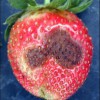 Florida’s producers use fungicides to manage anthracnose and botrytis fruit rot diseases, which find favorable growth conditions in Florida’s climate and can reduce strawberry yields and profits. The Strawberry Advisory System (SAS) uses information about weather conditions and user-entered information about past fungicide applications to evaluate the potential spread of these diseases in strawberry fields. If the risk of disease spread is low, no fungicide application is recommended, allowing producers to save on fungicide application costs. In this study, we summarize the results of a 2012/2013 survey of strawberry producers, and focus on the questions, How significant is the impact of anthracnose and botrytis on Florida strawberry producers’ yields? What are the typical fungicide application frequencies used by the producers? What percent of strawberry producers use SAS? and Are there any effects of SAS subscription on producers’ fungicide application? This 4-page fact sheet was written by Tatiana Borisova, Zhengfei Guan, Ekaterina Vorotnikova, Natalia Peres, and John VanSickle, and published by the UF Department of Food and Resource Economics, October 2014.
Florida’s producers use fungicides to manage anthracnose and botrytis fruit rot diseases, which find favorable growth conditions in Florida’s climate and can reduce strawberry yields and profits. The Strawberry Advisory System (SAS) uses information about weather conditions and user-entered information about past fungicide applications to evaluate the potential spread of these diseases in strawberry fields. If the risk of disease spread is low, no fungicide application is recommended, allowing producers to save on fungicide application costs. In this study, we summarize the results of a 2012/2013 survey of strawberry producers, and focus on the questions, How significant is the impact of anthracnose and botrytis on Florida strawberry producers’ yields? What are the typical fungicide application frequencies used by the producers? What percent of strawberry producers use SAS? and Are there any effects of SAS subscription on producers’ fungicide application? This 4-page fact sheet was written by Tatiana Borisova, Zhengfei Guan, Ekaterina Vorotnikova, Natalia Peres, and John VanSickle, and published by the UF Department of Food and Resource Economics, October 2014.
http://edis.ifas.ufl.edu/fe957
Powdery Mildew of Strawberries (PP208/PP129)
 Powdery mildew occurs in most areas of the world where strawberries are grown, infecting leaves, flowers, and fruit. Infected transplants are normally the primary source of inoculum for fruiting fields in Florida, but even disease-free fields can become infected by conidia blown in from neighboring fields. Fields with susceptible cultivars should be surveyed regularly for powdery mildew, especially early in the season. Usually, controlling foliar infection helps to prevent fruit infection. This 4-page fact sheet was written by N. A. Peres and J. C. Mertely, and published by the UF Department of Plant Pathology, May 2013.
Powdery mildew occurs in most areas of the world where strawberries are grown, infecting leaves, flowers, and fruit. Infected transplants are normally the primary source of inoculum for fruiting fields in Florida, but even disease-free fields can become infected by conidia blown in from neighboring fields. Fields with susceptible cultivars should be surveyed regularly for powdery mildew, especially early in the season. Usually, controlling foliar infection helps to prevent fruit infection. This 4-page fact sheet was written by N. A. Peres and J. C. Mertely, and published by the UF Department of Plant Pathology, May 2013.
http://edis.ifas.ufl.edu/pp129
Anthracnose Fruit Rot of Strawberry (PP207/PP130)
 Anthracnose fruit rot is an important disease for strawberry worldwide. Lesions appear as dark, sunken spots on infected fruit. This 4-page fact sheet was written by James C. Mertely and Natalia. A. Peres, and published by the UF Department of Plant Pathology, September 2012.
Anthracnose fruit rot is an important disease for strawberry worldwide. Lesions appear as dark, sunken spots on infected fruit. This 4-page fact sheet was written by James C. Mertely and Natalia. A. Peres, and published by the UF Department of Plant Pathology, September 2012.
http://edis.ifas.ufl.edu/pp130
Colletotrichum Crown Rot (Anthracnose Crown Rot) of Strawberries (PP238/PP156)
 Colletotrichum crown rot is caused by the fungi Colletotrichum gloeosporioides and Colletotrichum fragariae. Both pathogens kill strawberry plants by aggressively invading crown tissue. Crown rot is a serious disease in warm production regions, such as those in the southeastern United States. This 3-page fact sheet was written by Natalia A. Peres and Steven J. MacKenzie, and published by the UF Department of Plant Pathology, September 2012.
Colletotrichum crown rot is caused by the fungi Colletotrichum gloeosporioides and Colletotrichum fragariae. Both pathogens kill strawberry plants by aggressively invading crown tissue. Crown rot is a serious disease in warm production regions, such as those in the southeastern United States. This 3-page fact sheet was written by Natalia A. Peres and Steven J. MacKenzie, and published by the UF Department of Plant Pathology, September 2012.
http://edis.ifas.ufl.edu/pp156
PP273 Viral Diseases of Strawberries
PP273, a 7-page illustrated fact sheet by Catalina Moyer, Vance M. Whitaker, and Natalia A. Peres, provides
basic information on viral diseases of strawberries with particular emphasis on the presence of strawberry necrotic shock virus (SNSV) on Florida strawberry plants. Includes references. Published by the UF Department of Plant Pathology, April 2010.
http://edis.ifas.ufl.edu/pp273
AE450 A Web-based Decision Support Tool for Timing Fungicide Applications in Strawberry
AE450, a 5-page illustrated fact sheet by Willingthon Pavan, Clyde W. Fraisse, and Natália A. Peres, describes a web-based tool for timing fungicide applications in strawberries that can reduce the number of sprays and cost of production, especially in years when the conditions for disease are not favorable. Includes references. Published by the UF Department of Agricultural and Biological Engineering, August 2009.
http://edis.ifas.ufl.edu/AE450
